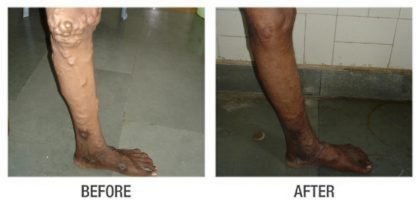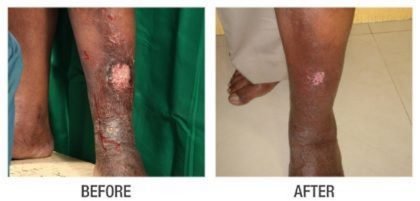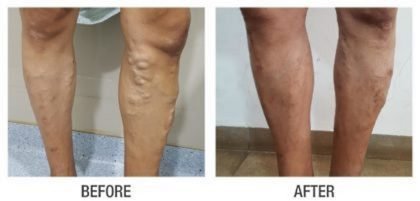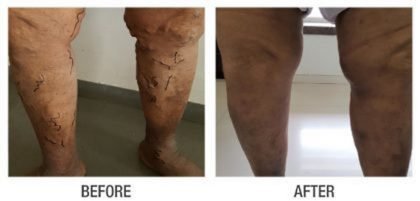Spider/ Varicose Veins Treatment
Varicose veins are visible, bulging unsightly veins in legs. They are not just a cosmetic problem. They can often cause pain, leg heaviness, night cramps, itching or swelling. If ignored, varicose veins can compromise the nutrition of skin and lead to pigmentation, skin thickening or ulceration and bleeding. Patients with varicose veins are also at a higher risk of Deep Vein Thrombosis (DVT).
The primary reason for development of varicose veins is reversal of blood flow due to vein wall weakness and impaired valve function. This reverse flow of impure blood is responsible for majority of complications of this disease.
Causes of varicose veins

- Heredity
- Hormonal – more common after pregnancy
- Dysfunctional vein valves
- Obesity and aging also play a role
Complications of varicose veins

- Eczema
- Skin ulcers
- Bleeding
- Thrombosis
Treatment of varicose veins

Over the recent years, lot many advances are made in the treatment of varicose veins. The type of treatment offered depends on many factors and no single method is the best! Your vascular specialist who is trained in all modalities can guide you to choose the best possible treatment for you!
1. Medicines & Stockings: Good symptomatic relief, but they cannot cure large varicose veins.
2. Surgery: Surgical ligation of the problem vein and removal of associated varicose veins is a gold standard treatment method in use for many years. The removal of these damaged veins does not harm the normal blood circulation of the leg.
3. Endovenous Laser or RFA (Radio Frequency Ablation) Treatment: A minimally invasive option in which the damaged veins are treated by needle puncture and passage of thin laser fiber which heats and seals the vein from inside. The advantages are better cosmetic result and rapid recovery with minimal side effects.
4. Doppler Guided Foam Sclerotherapy: This involves injection of a special chemical in the veins to block them. This can be used for recurrent varicose veins also. This procedure can leave behind a mild pigmentation mark.
5. Hook Phlebectomy: A minimally invasive surgical alternative useful for removal of large bunches of veins through minute holes by special hooks. This is used as an adjuvant method along with Laser or RFA of the main vein.
If you are suffering from varicose veins, seek advice from a vascular specialist who is an expert in treating varicose veins by all methods. Remember, not all patients with varicose veins are identical. Vascular specialists may vary in their preferred methods for investigations, treatment and aftercare.
Frequently asked questions
Varicose veins are swollen and enlarged or tortuous blood vessels/ veins which are larger in size. Spider Veins and reticular veins are purplish or bluish small sized visible veins that commonly develop in lower limbs.
Varicose Veins result from a weakening in the blood vessel wall or from faulty valves. It occurs when the walls of your veins weaken.
Due to high blood pressure in the vein, the weakened walls allow your vein to get bigger. As your vein stretches, the valves involved in blood moving in one direction in your vein can not work normally. As blood flow works more slowly than normal in a way that seems lazy, blood backs up or pools in your vein, causing your vein to swell, bulge and twist. Vein walls and valves may become weak for several reasons which includes Hormones, Normal Aging process, Obesity / excess weight, Clothing style particularly tight clothing, pressure inside the vein from standing for long periods.
Varicose veins are not considered a serious medical condition. Majorly, varicose veins are not a cause for concern. In very rare cases dangerous complications can occur due to varicose veins. People do not develop a serious or life threatening situation due to varicose veins but it can develop rate complications like blood clots (thrombophlebitis), minor bleeding close to the skin, ulcer on the skin near the varicose veins. Few research also suggests that people suffering with varicose veins are at increased risk of Deep Vein Thrombosis (DVT) where the blood clot develp in a deep vein and usually in the thigh or lower leg and Pulmonary Embolism (PE) where blood clot breaks off and travels to the lungs, which can be life threatening situation.
Varicose veins always don’t require treatment. But in some conditions your vascular surgeon may recommend the following types of treatments:
- Sclerotherapy: In this procedure your treating doctor inject a solution into the vein, causing scarring and shrinking. In this treatment varicose veins may fade within 2-3 weeks. This is an OPD based treatment.
- Laser: In this procedure your treating doctor use high end laser equipment, in this bursts of light are sent into small varicose veins after which varicose veins slowly fade away. This is performed as an endovascular procedure and utilized for larger veins.
For more advanced varicose vein problem, your treating doctor may recommend following treatment / procedures:
- Catheter assisted radio-frequency: This type of procedure is usually recommended to people having large varicose veins.
- High Ligation and vein stripping: In this treatment procedure, a vein is tied off before it connects to a deep vein and the vein is then removed via small incisions.
- Ambulatory Phlebectomy: In this procedure your doctor removes the smaller varicose veins through small skin punctures.
- Endoscopic Vein Surgery: This type of treatment is recommended in the situation where leg ulcers are involved and other treatment have already been tried for treating varicose vein problem
Varicose veins once detected have a tendency to increase in size. They do not show any spontaneous regression. However, Varicose Veins go away with the help of surgical treatment depending upon the type of varicose veins problem one has.
Varicose veins may be very common in some families due to inherited / strong family history. Varicose veins causes due to increased pressure in the veins and following are the major factors that may increase the risk:
- Overweight or Obesity
- Inactive life style / being inactive
- Leg Injury
- Pregnancy
- Smoking
- Taking oral contraceptive pills or hormone replacement therapy
- Being female as Varicose vein happens majorly with females
Yes, exercising regularly and keeping an active lifestyle may decrease the risk factor of getting varicose vein problems. Regular Walking exercise is good for varicose veins.
No, it is advisable not to leave varicose veins untreated as in some conditions varicose veins creates major complications and that can be very painful.
Yes, If varicose veins are left untreated. varicose veins have the potential to become severe, and even burst. Veins can grow larger as blood pools, putting increasing pressure on vein walls, which can grow thinner from the strain. Weakened like this, they can burst from even a minor trauma, scratching or even spontaneously.
It’s not advisable to leave varicose veins left untreated and hence a vascular surgical consult is useful to identify the severity of the problem. If you leave varicose veins untreated then you could put yourself at a risk for developing various complication like Skin Ulcers, Spontaneous Bleeding, Lipodermatesclerosis, Blood Clots, DVT or Pulmonary Embolism (PE).
One can always stop varicose veins getting worse by taking right advice at a right time from a right doctor, who is expert and experienced in treating Various types of Varicose Veins.
No, Varicose veins doesn’t go away naturally, one need to take right advice to at a right to get rid of Varicose Veins at the early stage by medication or lifestyle changes suggested by doctor.
Successful Treatments










